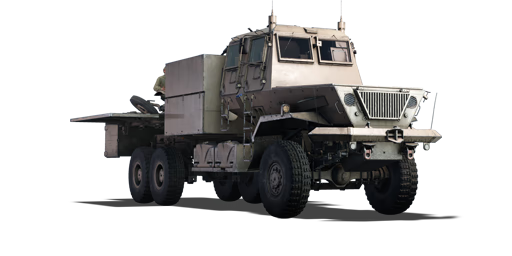




During the South African Border war, the Popular Movement for the Liberation of Angola (MPLA) utilized ZU-23-2 anti-aircraft guns against the South African Defense Forces (SADF). Designed by the Soviet Union, these anti-aircraft guns were also found to be very effective against infantry and light vehicles. The SADF would seize enough of these guns to partially utilize them as regular weapons in their army. In the early 1990s, the SAMIL-100 Kwêvol armoured cargo truck was selected by the Armaments Corporation of South Africa as a carrier for captured ZU-23-2 turrets, which were redesignated by the SADF as the GA-6. The Bosvark would fill the gap left behind by the earlier Ystervark, which was removed from frontline service in 1991.
Introduced in Update "Fire and Ice", the Bosvark is relatively fast and manoeuvrable for its size. Players can easily set up ambushes by hiding near buildings and waiting for unsuspecting enemy aircraft to fly low, making them an easy target. It is, however, larger than other SPAA vehicles at its tier, and many of its personnel are unprotected. As a result, it is critical for this vehicle to remain as hidden and unnoticed as possible until it is time to strike. A short burst from the Bosvark's autocannons can readily bring down any aircraft during battles. Players should keep in mind that the 23 mm ZU-23-2 will quickly deplete its ammunition and has a relatively long reload time, so it is recommended to not fire this weapon for longer than a few seconds at a time. Despite having access to armour-piercing ammunition belts, the armour penetration capability is insufficient to deal with the majority of tanks encountered during fights. Combined with the lack of weapon traverse towards the front section of the vehicle, it is not recommended to use the Bosvark in direct combat with enemy ground vehicles.
| Belt | Belt filling | Armor penetration (mm) at a distance: | |||||
|---|---|---|---|---|---|---|---|
| 10 m | 100 m | 500 m | 1000 m | 1500 m | 2000 m | ||
| API-T/HEF-I | 51 | 48 | 36 | 26 | 18 | 13 | |
| HEF-I/HEFI-T/HEF-I/API-T | 51 | 48 | 36 | 26 | 18 | 13 | |
| API-T/API-T/API-T/HEFI-T | 51 | 48 | 36 | 26 | 18 | 13 | |












Mobility | |
|---|---|
Protection |
|---|
Firepower | |
|---|---|